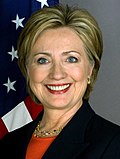
| ||
|---|---|---|
Personal
Illinois State Senator and U.S. Senator from Illinois 44th President of the United States
Tenure
 | ||
The Obama coalition was the combination of various voting blocs that supported the candidacy and presidency of Barack Obama. It consisted primarily of racial minorities, along with women and young voters. [1] It allowed for high vote share among cities and suburbs, as well as among voters that self-described as moderate. [2] The coalition formed in 2007 and 2008 as Obama campaigned for the presidency. During the 2008 election, the strength of the coalition gave Obama 53% of the vote. In 2012, he won reelection with 51% of the vote along similar demographic lines. [3] This made Obama the first Democratic president since Franklin D. Roosevelt's last two re-elections in 1940 and 1944 to win the majority of the popular vote in multiple elections.
Contents
The weaknesses of the coalition became apparent during the two midterm elections that took place during Obama's presidency. During the 2010 midterms, significant portions of the coalition failed to turn out or defected to the Republican Party. [4] [5] Similar results occurred in the 2014 midterms. [6] Hillary Clinton was described as attempting to continue the Obama coalition in order to win the presidential election in 2016, [7] with her loss to Donald Trump marking a failure to maintain the coalition. [8] [9]
During the 2020 Democratic Party presidential debates, Kamala Harris argued that it was necessary to "rebuild the Obama coalition" for the Democratic Party to win the presidential election. [1] After receiving the Democratic nomination, Obama's former Vice President Joe Biden was described as requiring a new coalition due to shifts in voting patterns over the previous years; the white working-class had moved away from the coalition while women aligned with it in stronger numbers. Shifts had also taken place among suburban and nonwhite voters. [10] In 2020, Biden won the presidential election with the same voting blocs as the Obama coalition, defeating incumbent president Donald Trump with 51% of the vote. [11]
In 2024, the coalition was claimed to be largely fallen apart as working class of all races had moved away from the coalition, causing Biden's Vice President Kamala Harris to lose the presidential election and the popular vote to former president Donald Trump. [12] [13] Nate Cohn of The New York Times stated that Trump had made larger gains with racial minorities than White voters without college degrees compared to the 2012 presidential election (the last pre-Trump election), with Democratic gains being mainly just among White voters with college degrees. [14]


